MENU
The Electronic Scholarly Publishing Project: Providing access to classic scientific papers and other scholarly materials, since 1993. More About: ESP | OUR CONTENT | THIS WEBSITE | WHAT'S NEW | WHAT'S HOT
Comparative Timelines
The ESP Timeline (one of the site's most popular features) has been completely updated to allow the user to select (using the timeline controls above each column) different topics for the left and right sides of the display.
Select:
New Left Column
New Left Column
Dates
Decade
New Right Column
New Right Column
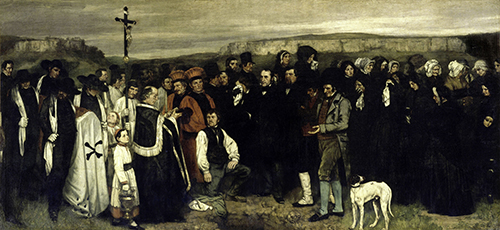 Painting by Gustave Courbet: A Burial At Ornans (French: Un enterrement à Ornans, also known as A Funeral At Ornans) represents one of the major turning points of 19th-century French art. The painting records the funeral in September 1848 of his great-uncle in the painter's birthplace, the small town of Ornans. It treats an ordinary provincial funeral with unflattering realism, and on the giant scale traditionally reserved for the heroic or religious scenes of history painting. Its exhibition at the 1850–51 Paris Salon created an "explosive reaction" and brought Courbet instant fame. It is currently displayed at the Musée d'Orsay in Paris, France.
Painting by Gustave Courbet: A Burial At Ornans (French: Un enterrement à Ornans, also known as A Funeral At Ornans) represents one of the major turning points of 19th-century French art. The painting records the funeral in September 1848 of his great-uncle in the painter's birthplace, the small town of Ornans. It treats an ordinary provincial funeral with unflattering realism, and on the giant scale traditionally reserved for the heroic or religious scenes of history painting. Its exhibition at the 1850–51 Paris Salon created an "explosive reaction" and brought Courbet instant fame. It is currently displayed at the Musée d'Orsay in Paris, France.
1850
(no entry for this year)
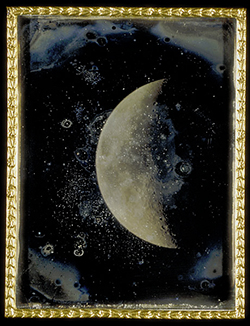 Daguerreotype by John Adams Whipple: Daguerreoype of the moon. Whipple was an American inventor and early photographer. He was the first in the United States to manufacture the chemicals used for daguerreotypes; he pioneered astronomical and night photography; he was a prize-winner for his extraordinary early photographs of the moon; and he was the first to produce images of stars other than the sun — the star Vega and the Mizar-Alcor stellar sextuple system, which was thought to be a double star until 2009.
Daguerreotype by John Adams Whipple: Daguerreoype of the moon. Whipple was an American inventor and early photographer. He was the first in the United States to manufacture the chemicals used for daguerreotypes; he pioneered astronomical and night photography; he was a prize-winner for his extraordinary early photographs of the moon; and he was the first to produce images of stars other than the sun — the star Vega and the Mizar-Alcor stellar sextuple system, which was thought to be a double star until 2009.
1851
 Nathaniel Hawthorne's The House of the Seven Gables and The Snow Image and Other Twice-Told Tales both appear.
Nathaniel Hawthorne's The House of the Seven Gables and The Snow Image and Other Twice-Told Tales both appear.
 Moby Dick, by Herman Melville, is published.
Moby Dick, by Herman Melville, is published.
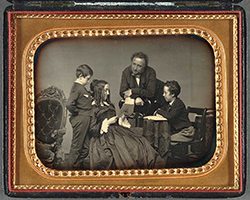 Daguerreotype by John Adams Whipple: Henry Winthrop Sargent and His Family. Whipple kept several distinctive pieces of furniture in his studio that he used to solidify his compositions by disposing them within an image in characteristic ways without having the sitter use them. In fact, it is this unique posing style that identifies Whipple as the artist of the portrait of Henry Winthrop Sargent and his family, taken in Boston in the early 1850s. Here, Whipple's composition is complex and masterful. The empty armchair at the lower left faces the viewer and draws the eye in. The covered table at the far right connects an occupied chair to the edge of the plate and suggests a vanishing point while giving diagonal movement to what is basically a horizontal composition. The corner of a plain backdrop, barely perceptible at the right, aids the illusion of movement and space. The empty armchair acts as a backrest for young Francis Sargent, who is actually supported by a posing stand, the base of which can be seen between his feet and his mother's skirts. Caroline Olmsted Sargent appears to be reading a letter to her assembled family. Her oldest son, Winthrop Henry Sargent, sits facing her, and their profiles echo across the space as he leans toward her. Henry Winthrop Sargent, at the apex of the composition, leans dynamically into the gathering, supporting his weight on the back of a carved side chair. The division of the family into two pairs of linked figures creates powerful parallel diagonals; but despite this calculated arrangement, all of the sitters appear to be at ease and engaged with one another.
Daguerreotype by John Adams Whipple: Henry Winthrop Sargent and His Family. Whipple kept several distinctive pieces of furniture in his studio that he used to solidify his compositions by disposing them within an image in characteristic ways without having the sitter use them. In fact, it is this unique posing style that identifies Whipple as the artist of the portrait of Henry Winthrop Sargent and his family, taken in Boston in the early 1850s. Here, Whipple's composition is complex and masterful. The empty armchair at the lower left faces the viewer and draws the eye in. The covered table at the far right connects an occupied chair to the edge of the plate and suggests a vanishing point while giving diagonal movement to what is basically a horizontal composition. The corner of a plain backdrop, barely perceptible at the right, aids the illusion of movement and space. The empty armchair acts as a backrest for young Francis Sargent, who is actually supported by a posing stand, the base of which can be seen between his feet and his mother's skirts. Caroline Olmsted Sargent appears to be reading a letter to her assembled family. Her oldest son, Winthrop Henry Sargent, sits facing her, and their profiles echo across the space as he leans toward her. Henry Winthrop Sargent, at the apex of the composition, leans dynamically into the gathering, supporting his weight on the back of a carved side chair. The division of the family into two pairs of linked figures creates powerful parallel diagonals; but despite this calculated arrangement, all of the sitters appear to be at ease and engaged with one another.
1852
 Harriet Beecher Stowe publishes her anti-slavery novel, Uncle Tom's Cabin.
Harriet Beecher Stowe publishes her anti-slavery novel, Uncle Tom's Cabin.
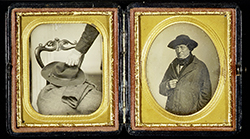 Daguerreotype by John Adams Whipple: Cornelius Conway Felton with His Hat and Coat. Felton was Eliot Professor of Greek Literature at Harvard University, reaching for his felt hat and duster. The first son of a poverty-stricken furniture maker, Felton became one of the most renowned classical scholars in the country and, in 1860, Harvard's president. This witty photograph lampoons the rigid formality of the portrait process through narrative gesture (the implied reach across two separate images) and nuance (the delicate crush of the soft hat's crown). As opposed to the inflexible silk top hat worn by dandies and professors alike, the broad-brimmed felt hat was worn by outdoorsmen and was practical, casual, and fundamentally democratic.
Daguerreotype by John Adams Whipple: Cornelius Conway Felton with His Hat and Coat. Felton was Eliot Professor of Greek Literature at Harvard University, reaching for his felt hat and duster. The first son of a poverty-stricken furniture maker, Felton became one of the most renowned classical scholars in the country and, in 1860, Harvard's president. This witty photograph lampoons the rigid formality of the portrait process through narrative gesture (the implied reach across two separate images) and nuance (the delicate crush of the soft hat's crown). As opposed to the inflexible silk top hat worn by dandies and professors alike, the broad-brimmed felt hat was worn by outdoorsmen and was practical, casual, and fundamentally democratic.
1853
(no entry for this year)
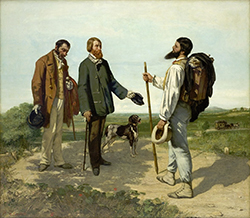 Painting by Gustave Courbet: The Meeting (French: La rencontre) is traditionally interpreted as Courbet greeted by his patron Alfred Bruyas, his servant Calas, and his dog while traveling to Montpellier. The composition is based on the Wandering Jew. The Meeting was exhibited in Paris at the 1855 Exhibition Universelle, where critics ridiculed it as "Bonjour, Monsieur Courbet". Bruyas did not exhibit The Meeting until he donated it to the Musée Fabre in Montpellier in 1868.
Painting by Gustave Courbet: The Meeting (French: La rencontre) is traditionally interpreted as Courbet greeted by his patron Alfred Bruyas, his servant Calas, and his dog while traveling to Montpellier. The composition is based on the Wandering Jew. The Meeting was exhibited in Paris at the 1855 Exhibition Universelle, where critics ridiculed it as "Bonjour, Monsieur Courbet". Bruyas did not exhibit The Meeting until he donated it to the Musée Fabre in Montpellier in 1868.
1854
 Henry David Thoreau's Walden, or Life in the Woods is published.
Henry David Thoreau's Walden, or Life in the Woods is published.
(no entry for this year)
1855
 Henry Wadsworth Longfellow's "Song of Hiawatha" appears.
Henry Wadsworth Longfellow's "Song of Hiawatha" appears.
 Poet Walt Whitman publishes a volume of twelve poems, Leaves of Grass, at his own expense, and meets with no commercial success.
Poet Walt Whitman publishes a volume of twelve poems, Leaves of Grass, at his own expense, and meets with no commercial success.
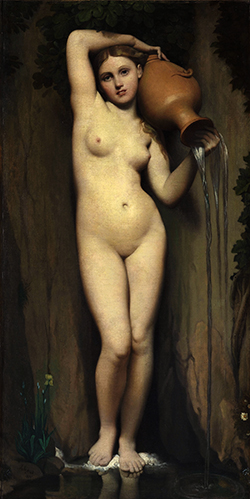 Painting by Jean Auguste Dominique Ingres: The Source (French: La Source), was begun in Florence around 1820 and not completed until 1856, in Paris. When Ingres completed The Source, he was seventy-six years old, already famous, and president of the cole des Beaux-Arts. The pose of the nude may be compared with that of another by Ingres, the Venus Anadyomene (1848), and is a reimagination of the Aphrodite of Cnidus or Venus Pudica. Two of Ingres' students, painters Paul Balze and Alexandre Desgoffe, helped to create the background and water jar. The first exhibition of The Source was in 1856, the year it was completed. The painting was received enthusiastically. Duch tel acquired the painting in 1857 for a sum of 25,000 francs. The state assumed title to the painting in 1878 and it passed to the Mus e du Louvre. In 1986 it was transferred to the Mus e d'Orsay. The painting has been frequently exhibited and widely published. Haldane Macfall in A History of Painting: The French Genius describes The Source as Ingres' "superb nude by which he is chiefly known". Kenneth Clark in his book Feminine Beauty observed how The Source has been described as "the most beautiful figure in French painting."
Painting by Jean Auguste Dominique Ingres: The Source (French: La Source), was begun in Florence around 1820 and not completed until 1856, in Paris. When Ingres completed The Source, he was seventy-six years old, already famous, and president of the cole des Beaux-Arts. The pose of the nude may be compared with that of another by Ingres, the Venus Anadyomene (1848), and is a reimagination of the Aphrodite of Cnidus or Venus Pudica. Two of Ingres' students, painters Paul Balze and Alexandre Desgoffe, helped to create the background and water jar. The first exhibition of The Source was in 1856, the year it was completed. The painting was received enthusiastically. Duch tel acquired the painting in 1857 for a sum of 25,000 francs. The state assumed title to the painting in 1878 and it passed to the Mus e du Louvre. In 1986 it was transferred to the Mus e d'Orsay. The painting has been frequently exhibited and widely published. Haldane Macfall in A History of Painting: The French Genius describes The Source as Ingres' "superb nude by which he is chiefly known". Kenneth Clark in his book Feminine Beauty observed how The Source has been described as "the most beautiful figure in French painting."
1856
(no entry for this year)
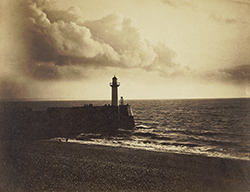 Photograph by Gustave Le Gray: Lighthouse and Jetty, le Havre, an albumen print.
Photograph by Gustave Le Gray: Lighthouse and Jetty, le Havre, an albumen print.
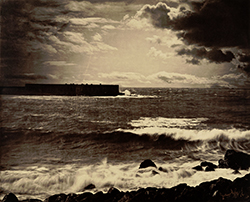 Photograph by Gustave Le Gray: The Great Wave. The dramatic effects of sunlight, clouds, and water in Le Gray's seascapes stunned his contemporaries and immediately brought him international recognition. At a time when photographic emulsions were not equally sensitive to all colors of the spectrum, most photographers found it impossible to achieve proper exposure of both landscape and sky in a single picture. Le Gray solved this problem by printing two negatives on a single sheet of paper: one exposed for the sea, the other for the sky, and sometimes made on separate occasions or in different locations. Le Gray's marine pictures caused a sensation not only because their simultaneous depiction of sea and heavens represented a technical tour de force, but also because the resulting poetic effect was without precedent in photography.
Photograph by Gustave Le Gray: The Great Wave. The dramatic effects of sunlight, clouds, and water in Le Gray's seascapes stunned his contemporaries and immediately brought him international recognition. At a time when photographic emulsions were not equally sensitive to all colors of the spectrum, most photographers found it impossible to achieve proper exposure of both landscape and sky in a single picture. Le Gray solved this problem by printing two negatives on a single sheet of paper: one exposed for the sea, the other for the sky, and sometimes made on separate occasions or in different locations. Le Gray's marine pictures caused a sensation not only because their simultaneous depiction of sea and heavens represented a technical tour de force, but also because the resulting poetic effect was without precedent in photography.
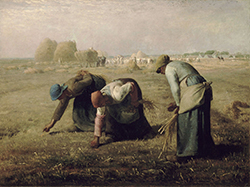 Painting by Jean-François Millet: The Gleaners (Des glaneuses) depicts three peasant women gleaning a field of stray grains of wheat after the harvest. The painting is famous for featuring in a sympathetic way what were then the lowest ranks of rural society; this was received poorly by the French upper classes. The painting immediately drew negative criticism from the middle and upper classes, who viewed the topic with suspicion: one art critic, speaking for other Parisians, perceived in it an alarming intimation of "the scaffolds of 1793." Its size (33×44 inches) was also considered offensive, as it was too large for an image depicting mere labor.
Painting by Jean-François Millet: The Gleaners (Des glaneuses) depicts three peasant women gleaning a field of stray grains of wheat after the harvest. The painting is famous for featuring in a sympathetic way what were then the lowest ranks of rural society; this was received poorly by the French upper classes. The painting immediately drew negative criticism from the middle and upper classes, who viewed the topic with suspicion: one art critic, speaking for other Parisians, perceived in it an alarming intimation of "the scaffolds of 1793." Its size (33×44 inches) was also considered offensive, as it was too large for an image depicting mere labor.
1857
(no entry for this year)
(no entry for this year)
1858
(no entry for this year)
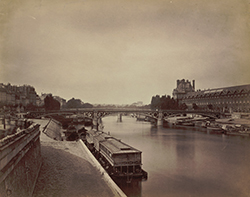 Photograph by Gustave Le Gray: The Pont du Carrousel Seen from the Pont Royal, an albumen print.
Photograph by Gustave Le Gray: The Pont du Carrousel Seen from the Pont Royal, an albumen print.
1859
(no entry for this year)
ESP Quick Facts
ESP Origins
In the early 1990's, Robert Robbins was a faculty member at Johns Hopkins, where he directed the informatics core of GDB — the human gene-mapping database of the international human genome project. To share papers with colleagues around the world, he set up a small paper-sharing section on his personal web page. This small project evolved into The Electronic Scholarly Publishing Project.
ESP Support
In 1995, Robbins became the VP/IT of the Fred Hutchinson Cancer Research Center in Seattle, WA. Soon after arriving in Seattle, Robbins secured funding, through the ELSI component of the US Human Genome Project, to create the original ESP.ORG web site, with the formal goal of providing free, world-wide access to the literature of classical genetics.
ESP Rationale
Although the methods of molecular biology can seem almost magical to the uninitiated, the original techniques of classical genetics are readily appreciated by one and all: cross individuals that differ in some inherited trait, collect all of the progeny, score their attributes, and propose mechanisms to explain the patterns of inheritance observed.
ESP Goal
In reading the early works of classical genetics, one is drawn, almost inexorably, into ever more complex models, until molecular explanations begin to seem both necessary and natural. At that point, the tools for understanding genome research are at hand. Assisting readers reach this point was the original goal of The Electronic Scholarly Publishing Project.
ESP Usage
Usage of the site grew rapidly and has remained high. Faculty began to use the site for their assigned readings. Other on-line publishers, ranging from The New York Times to Nature referenced ESP materials in their own publications. Nobel laureates (e.g., Joshua Lederberg) regularly used the site and even wrote to suggest changes and improvements.
ESP Content
When the site began, no journals were making their early content available in digital format. As a result, ESP was obliged to digitize classic literature before it could be made available. For many important papers — such as Mendel's original paper or the first genetic map — ESP had to produce entirely new typeset versions of the works, if they were to be available in a high-quality format.
ESP Help
Early support from the DOE component of the Human Genome Project was critically important for getting the ESP project on a firm foundation. Since that funding ended (nearly 20 years ago), the project has been operated as a purely volunteer effort. Anyone wishing to assist in these efforts should send an email to Robbins.
ESP Plans
With the development of methods for adding typeset side notes to PDF files, the ESP project now plans to add annotated versions of some classical papers to its holdings. We also plan to add new reference and pedagogical material. We have already started providing regularly updated, comprehensive bibliographies to the ESP.ORG site.
ESP Picks from Around the Web (updated 06 MAR 2017 )
Old Science

Weird Science

Treating Disease with Fecal Transplantation
Fossils of miniature humans (hobbits) discovered in Indonesia

Dinosaur tail, complete with feathers, found preserved in amber.
Astronomy

Mysterious fast radio burst (FRB) detected in the distant universe.